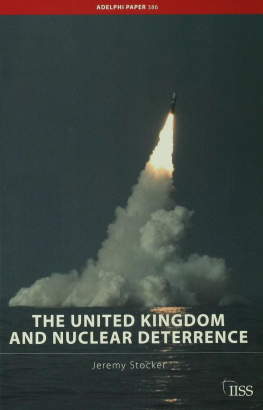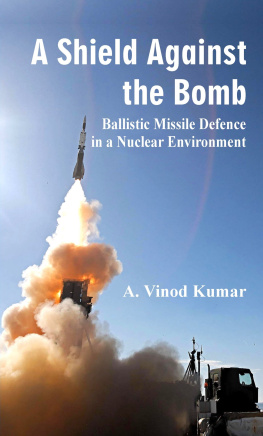
BRITAIN AND BALLISTIC MISSILE DEFENCE 19422002
Cass Series: Strategy and History
Series Editors: Colin S.Gray and Williamson Murray
ISSN: 1473-6403
This new series focuses on the theory and practice of strategy. Following Clausewitz, strategy has been understood to mean the use made of force, and the threat of the use of force, for the ends of policy. This series is as interested in ideas as in historical cases of grand strategy and military strategy in action. All historical periods, near and past, and even future, are of interest. In addition to original monographs, the series will from time to time publish edited reprints of neglected classics as well as collections of essays.
- Military Logistics and Strategic Performance,
Thomas M.Kane
- Strategy for Chaos: Revolutions in Military Affairs and the Evidence of History,
Colin S.Gray
- The Myth of Inevitable US Defeat in Vietnam,
C.Dale Walton
- Astropolitik: Classical Geopolitics in the Space Age,
Everett C.Dolman
- Astropolitik: Classical Geopolitics in the Space Age,
Everett C.Dolman
- Anglo-American Strategic Relations and the Far East, 19331939: Imperial Crossroads,
Greg Kennedy
- Power and Policy in the Space and Information Age: Pure Strategy,
Everett C.Dolman
- The Red Army, 19181941: From Vanguard of World Revolution to US Ally,
Earl F.Ziemke
- Britain and Ballistic Missile Defence 19422002,
Jeremy Stocker
BRITAIN AND BALLISTIC MISSILE DEFENCE 19422002
JEREMY STOCKER
First published 2004 by FRANK CASS 11 New Fetter Lane, London EC4P 4EE
Simultaneously published in the USA and Canada by FRANK CASS 29 West 35th Street, New York, NY 10001
FRANK CASS is an imprint of the Taylor & Francis Group
This edition published in the Taylor & Francis e-Library, 2005.
To purchase your own copy of this or any of Taylor & Francis or Routledges collection of thousands of eBooks please go to http://www.ebookstore.tandf.co.uk/.
2004 Jeremy Stocker
All rights reserved. No part of this book may be reprinted or reproduced or utilized in any form or by any electronic, mechanical, or other means, now known or hereafter invented, including photocopying and recording, or in any information storage or retrieval system, without permission in writing from the publishers.
British Library Cataloguing in Publication Data A catalogue record for this book is available from the British Library
Library of Congress Cataloging-in-Publication Data Stocker, Jeremy Britain and ballistic missile defence, 19422 002/Jeremy Stocker p. cm(Cass seriesstrategy and history, ISSN 1473-6403; 8) Includes bibilographical references and index. 1. Ballistic missile defenses-Great Britain History. 1. Title. II. Series
ISBN 0-203-30963-4 Master e-book ISBN
ISBN - (Adobe e-Reader Format)
ISBN 0-714-65696-8 (Print Edition)
To my Father, Group Captain John Stocker RAF,
whose career in air defence spanned most of the period considered in this book
List of Illustrations
. V-2 German rocket
. Duncan Sandys addresses the Crossbow press conference, 7 September 1944
. V-2 damage in Islington, North London
. Chain Home radars
. 3.7-inch AA guns
. German V-2 rocket being prepared for test-firing, late 1945
. Bloodhound missile
. Jodrell Bank radio telescope
. Vulcan bomber with Blue Steel-powered bomb
. Polaris missile
. RAF Fylingdales, 1992
. Aster missile
List of Figures
. Typical Ballistic Missile Trajectory.
. Summary of Ballistic Missile Interception Terminology.
. An Early Outline Design for an ABM Interceptor.
. Early warning sites in Britain.
. BMEWS Vertical Coverage Diagram.
. BMEWS Warning Times v. 1,500-mile missiles. (optimum trajectory)
. BMEWS Warning Times v. 650-mile missiles. (depressed trajectory)
. Anticipated Coverage of the Moscow BMD system.
. Missile Proliferation.
. European Ranges of TBMs.
. TRRAP Report.
. Countries Operating Ballistic Missiles.
Series Editors Preface
An important function of this Series is to offer analyses of episodes or themes in strategic history that have been thus far neglected. The subject of Jeremy Stockers study of Britain and Ballistic Missile Defence, 19422002, falls four-square in the neglected category. On 8 September, 1944, Britain was the first victim in history to suffer assault by a ballistic missile (Germanys V-2). From that time to the present day, the country has a continuous, if often all but inactive, record of concern about, and some involvement in, ballistic missile defence (BMD). Despite that lengthy experience, prior to the publication of Dr. Stockers book there was no extant comprehensive examination of Britain and BMD. The author claims, without risk of contradiction, to provide the first study that traces the full history of how Britain responded to the challenge posed by the menace of ballistic missile attack over a period of no less than sixty years.
It is somewhat surprising that this should be such an innovative work. After all, since the late 1960s BMD has been by far the single most controversial topic in Western defence strategy, and arms control. Indeed, as Dr. Stocker makes abundantly clear, although his subject is Britain and BMD, the main issue almost always has been Britains attitude towards the latest shift in American policy on the matter. Inhabiting a small and crowded island, the British have long elected to adopt a principally political approach to their national security in the nuclear age. In the context of a large, then very large, Soviet nuclear-missile threat, even a fairly competent BMD architecture did not have much to offer Britain by way of reliable physical protection. That strategic judgment is offered in addition, of course, to the all too obvious issues of military-technical feasibility and affordability. In British, indeed in NATO-European, eyes, the first line of security against the nuclear-missile menace was diplomacy. For reasons of political culture, strategic conviction, and expediency, Britainand Europe, more generallyhas always looked to arms control diplomacy to provide, or at least help shape, a context that would blunt the missile danger. Dr. Stocker makes the point with an admirable directness. He characterises the ABM Treaty of 1972 as the defining event in the UKs responses to both US and Soviet ABMs (p.6). Literally for thirty years the Treaty served as the Hindenburg Line against the periodic flurry of renewed US interest in moving BMD from research and development into a more active phase. In the Cold War years, at least, the Treaty was portrayed as the essential protector against a more heated strategic arms race (defence-offence, or offence-defence).
BMD is a deeply technical subject, as the authors narrative makes very plain. However, if anything it is even more deeply political than technical. The ABM Treaty was regarded, by its friends and foes alike, as the jewel in the crown of arms control. It was the most substantial achievement of arms control policy and diplomacy in the Cold War. A rigorous critic of the Treaty, Dr. Donald G. Brennan, observed ruefully at the time that the Treaty did the wrong thing well. The Treaty denied the superpower signatories the right to deploy a missile defence of their national territory. The theology of nuclear era strategic theory was central to the argument. Allegedly, it was beneficial for strategic stabilitythe holy grail of the periodfor each side to enjoy unrestricted military access to the others society. More theology asserted that defensive systems must spur the deployment of more, or more sophisticated, offensive weapons: so BMD inexorably would fuel a defence-offence spiral of arms competition. For a quarter century, strategic theorists and defence analysts engaged repeatedly in the kind of expert strategic debate that tends to give such debate a bad name. Theories were advanced as factson both sides, let it be saidand the only certainty about the subject was that BMD was a topic that would be certain to come round again in the next major review of US nation-al security policy. Although the issues could hardly be more technical, the on-off-on debate was always dominated by political attitudes. BMD became an iconic subject, for all parties to the long running dispute.














